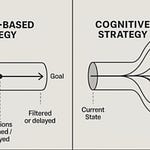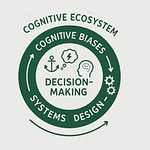Legacy Thinking in a Modern World
So, just how old is your operating system?
These days our phones update themselves, but what about your brain?
Most of our thinking is still running on legacy code that we built in 2003.
And that's because the cognitive schemas, the mental models that we form before we're 18, they end up shaping about 65% of all of our adult decisions.
But only 15% of people actually bother to update them.
Now, that's not a problem. That's an opportunity.
It's not time for a reboot. It's time for an upgrade.
And because the brain automates what feels familiar, especially if we've been doing something for 20 years, that becomes our default mode.
And the problem with default is default doesn't scale.
The Cost of Sticking to Old Models
60% of failed transformations, they don't come from technical errors.
They come from these mental model misfires.
They come from using the wrong mental model at the wrong time or...
Even when we know it's not going to work, we still do it.
We used to think that information was the problem.
We used to think that if we had more information, we would make better decisions.
But what we know now is that information and data, it's not the problem.
Because when we're given more data, three out of four people, they end up making slower decisions.
And the higher the stakes are, the slower the decision ends up.
Now, this isn't collapse. This is compression.
The model, it can't keep up with the input.
And so what we're seeing here is a buffering issue.
Too much is going in, but we haven't changed anything.
So we end up with leadership that it feels and it sounds sharp, but it comes with all of this cognitive drag and all of this decision fatigue.
And so when we actually get into it, everything feels slow. It feels sluggish.
And that's because the world is faster. Everything is faster.
But we're still using the same framework and expecting it to keep up.
Change and the Modern Organization
Everywhere is getting faster.
Let's talk about change in organizations.
There used to be maybe one big change a year, maybe one big change every two years.
The new normal for the average organization is five big changes every single year. Five.
So most ways that we think and that we've been taught to think, they're designed for a tempo that doesn't exist anymore.
We know that things are moving faster generally in the world, but we're not really trying to keep up.
We kind of think it'll all just work out and that's where we're being left behind.
The good news is most people are being left behind together.
Over half of CEOs, they think that their current business model, it will be obsolete in five years.
Nine out of 10, they feel overwhelmed by the current complexity.
We've got 6% of CEOs who currently feel equipped to handle the current complexity.
So this isn't about falling behind. This is about trying to play chess on a board that's already half melted.
Your Brain is Still Running
Your brain, it's still working. It's still doing exactly what it always has.
It's just running Windows 95 in a world that's all streaming.
And this is all to do with how much information we have to process every single day these days.
There's so much more that we need to consider.
Remember we just used to read a newspaper and there was stuff in it and we read it.
Now we get all of this information from every direction at every single second of the day.
And when the number of decision-making inputs evolve faster than our mental models are able to adjust, our decision-making quality, it nosedives, it goes down.
The Opportunity: Upgrade the Processor
So the opportunity here is don't just update your processes, update the processor.
It isn't stuck. It's just waiting for the next model update.
And when I start to think about a world where everybody is updating their thinking and where updating your thinking becomes normal, that's the kind of world that I want to live in.
Imagine if this was standard. Not a breakthrough, not a mindset shift, just basic cognitive hygiene, like brushing your teeth, but for the way that you think.
If we had this world... Ideas, they wouldn't get stuck. Models would flex. They'd be reviewed. They'd be revised. They'd be retired, just like your first email address.
Lock it away. We don't talk about that anymore.
Thinking as Shared Infrastructure
We would start to think of thinking as a shared infrastructure.
And this means that schools, they would stop getting people to memorize things.
Instead, they would actually help them improve their thinking.
Teams in organizations, they would run regular mental model audits and not to catch anybody out, but to make sure everybody's keeping up.
And this is early, but this is coming.
Mental model reviews, they could become as normal as any post-project review.
Some organizations, they're already experimenting with what they're calling cognitive freshness dashboards.
So updating your logic, it could soon become a collective habit.
Thinking as a System
And this is where it gets exciting because if we start treating thinking like a system, that means we can start to maintain it like a system.
And that brings with it cleaner thinking, faster flows of thought.
When thinking comes with routine maintenance, everything shifts.
Decision cycles, they move faster.
Strategy doesn't stall.
Internal adaptability and resilience, it rises because people aren't stuck anymore.
They're not stuck mentally. They're not stuck structurally.
And across the board, we just end up with happier people, less polarization, less regret.
And not because people change entirely, but because they're thinking.
It's being updated in real time, just like everything else in the world these days.
Individual Logic, Collective Harmony
And also, I do mean your mental models.
I'm not talking about you thinking in the way that somebody else is thinking.
This is not about consensus. This is about harmony and synchrony.
It's not about everybody being the same.
And now this shift is already happening.
Whether you're seeing it or not, it's already happening.
And it's good because mental models, they don't announce when they're going to expire.
They don't say, hey, I'm a bit tired. I'm probably going to dip.
They just stop working mid-meeting, mid-sentence, mid-thought.
And that misfire, it's not incompetence. It's just lag. It's buffering.
Schema Slippage and the Need for Real-Time Updates
But if everything is working in harmony, why do we have these slips?
Well, it's not sabotage. It's just schema slippage.
This is because social logic, it refreshes about every 18 months.
And most people don't keep up.
We're still working on social logic from 10 cycles ago.
So it's not because people are wrong. It's just because somewhere something hasn't kept up.
So we're not asking the question anymore of should we do this?
That question, it's done. It's out of date.
This is not about a mindset shift. This is about an operating upgrade.
The tipping point has already tipped.
Identity is not a statute. It's a stack.
You know, we are modular. We're built to adapt.
So we need to collectively make that shift from operator to thinker.
We're not just making decisions and pushing buttons.
We're maintaining a system that allows decisions to be made.
And when we start to think about thinking as a system that can be maintained with routine maintenance, then we realize that we can continually be updated in real time.
And because your identity is just the current version of your logic, that means that logic can always be updated to something better.
🔁 Enjoy this episode? Subscribe now!
🟢 The Neurostrategist video podcast is always part of the free tier.
Join the bold thinkers upgrading how they think each week — through science, sound, and smarter systems.
👉 Subscribe now to stay up with the latest episodes.








Share this post